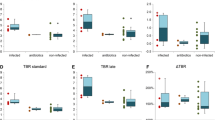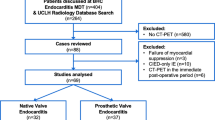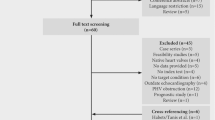Abstract
Background
We examined the use of [18F]FDG-PET/CT for the diagnosis of native valve endocarditis (NVE).
Methods
PET/CT images in patients with suspected NVE were retrospectively reviewed independently by two experienced physicians blinded to all clinical information. The gold standard consisted of surgical findings, when available, or the modified Duke criteria.
Results
Fifty four subjects were included, 31 (57%) with a diagnosis of NVE. [18F]FDG-PET/CT correctly identified 21/31 (67.7%) subjects, yielding a sensitivity and specificity of 68% (95% CI 49-83%) and 100% (95% CI 85-100%), respectively. The sensitivity and specificity of the modified Duke criteria were 48% and 74%, respectively. Positive and negative predictive values of PET were 100% (95% CI 84-100%) and 70% (95% CI 51-84%), respectively. Modifying the Duke criteria to include [18F]FDG-PET positivity as a major criterion increased sensitivity to 77% without affecting specificity and led to the correct reclassification of 8/18 (44.4%) subjects from Possible IE to Definite IE.
Conclusion
The addition of a positive [18F]FDG-PET/CT as a major criterion in the modified Duke Criteria improved performance of the criteria for the diagnosis of NVE, particularly in those subjects with Possible IE.




Similar content being viewed by others
Abbreviations
- IE:
-
Infective Endocarditis
- NVE:
-
Native valve endocarditis
- PVE:
-
Prosthetic valve endocarditis
- TEE:
-
Transesophageal echocardiogram
- TTE:
-
Transthoracic echocardiogram
References
Pant S, Patel NJ, Deshmukh A, et al. Trends in infective endocarditis incidence, microbiology, and valve replacement in the United States from 2000 to 2011. J Am Coll Cardiol. 2015;65:2070–6. https://doi.org/10.1016/j.jacc.2015.03.518.
Toyoda N, Chikwe J, Itagaki S, et al. Trends in infective endocarditis in California and New York state, 1998–2013. JAMA. 2017;317:1652–60. https://doi.org/10.1001/jama.2017.4287.
Hoen B, Duval X. Clinical practice. Infective endocarditis. N Engl J Med. 2013;368:1425–33. https://doi.org/10.1056/NEJMcp1206782.
Raoult D, Casalta JP, Richet H, et al. Contribution of systematic serological testing in diagnosis of infective endocarditis. J Clin Microbiol. 2005;43:5238–42. https://doi.org/10.1128/JCM.43.10.5238-5242.2005.
Murdoch DR, Corey GR, Hoen B, et al. Clinical presentation, etiology, and outcome of infective endocarditis in the 21st century: The International Collaboration on Endocarditis-Prospective Cohort Study. Arch Intern Med. 2009;169:463–73. https://doi.org/10.1001/archinternmed.2008.603.
Morris AJ, Drinkovic D, Pottumarthy S, et al. Gram stain, culture, and histopathological examination findings for heart valves removed because of infective endocarditis. Clin Infect Dis. 2003;36:697–704. https://doi.org/10.1086/367842.
Lamas CC, Fournier P-E, Zappa M, et al. Diagnosis of blood culture-negative endocarditis and clinical comparison between blood culture-negative and blood culture-positive cases. Infection. 2016;44:459–66. https://doi.org/10.1007/s15010-015-0863-x.
Topan A, Carstina D, Slavcovici A, et al. Assesment of the Duke criteria for the diagnosis of infective endocarditis after twenty-years. An analysis of 241 cases. Clujul Med. 2015;88:321–6. https://doi.org/10.15386/cjmed-469.
Prendergast BD. Diagnostic criteria and problems in infective endocarditis. Heart. 2004;90:611–3. https://doi.org/10.1136/hrt.2003.029850.
Habib G, Lancellotti P, Antunes MJ, et al. 2015 ESC Guidelines for the management of infective endocarditis: The Task Force for the Management of Infective Endocarditis of the European Society of Cardiology (ESC). Endorsed by: European Association for Cardio-Thoracic Surgery (EACTS), the European Association of Nuclear Medicine (EANM). Eur Heart J. 2015;36:3075–128. https://doi.org/10.1093/eurheartj/ehv319.
Baddour LM, Wilson WR, Bayer AS, et al. Infective endocarditis in adults: Diagnosis, antimicrobial therapy, and management of complications: A scientific statement for healthcare professionals from the American Heart Association. Circulation. 2015;132:1435–86. https://doi.org/10.1161/CIR.0000000000000296.
Habib G. Management of infective endocarditis. Heart. 2006;92:124–30. https://doi.org/10.1136/hrt.2005.063719.
Fukuchi T, Iwata K, Ohji G. Failure of early diagnosis of infective endocarditis in Japan—a retrospective descriptive analysis. Medicine. 2014. https://doi.org/10.1097/MD.0000000000000237.
Al-Zaghal A, Raynor WY, Seraj SM, et al. FDG-PET imaging to detect and characterize underlying causes of fever of unknown origin: An unavoidable path for the foreseeable future. Eur J Nucl Med Mol Imaging. 2019;46:2–7. https://doi.org/10.1007/s00259-018-4164-3.
Hariri H, Tan S, Martineau P, et al. Utility of FDG-PET/CT for the detection and characterization of sternal wound infection following sternotomy. Nucl Med Mol Imaging. 2019. https://doi.org/10.1007/s13139-019-00599-6.
Rojoa D, Kontopodis N, Antoniou SA, et al. 18F-FDG PET in the diagnosis of vascular prosthetic graft infection: A diagnostic test accuracy meta-analysis. Eur J Vasc Endovasc Surg. 2019;57:292–301. https://doi.org/10.1016/j.ejvs.2018.08.040.
Sarrazin J-F, Trottier M, Tessier M. How useful is 18F-FDG PET/CT in patients with suspected vascular graft infection? J Nucl Cardiol. 2018. https://doi.org/10.1007/s12350-018-1377-6.
Sarrazin J-F, Philippon F, Trottier M, Tessier M. Role of radionuclide imaging for diagnosis of device and prosthetic valve infections. World J Cardiol. 2016;8:534–46. https://doi.org/10.4330/wjc.v8.i9.534.
Sarrazin J-F, Philippon F, Tessier M, et al. Usefulness of fluorine-18 positron emission tomography/computed tomography for identification of cardiovascular implantable electronic device infections. J Am Coll Cardiol. 2012;59:1616–25. https://doi.org/10.1016/j.jacc.2011.11.059.
Abikhzer G, Turpin S, Bigras J-L. Infected pacemaker causing septic lung emboli detected on FDG PET/CT. J Nuclear Cardiol. 2010;17:514–5.
Saby L, Laas O, Habib G, et al. Positron emission tomography/computed tomography for diagnosis of prosthetic valve endocarditis: increased valvular 18F-fluorodeoxyglucose uptake as a novel major criterion. J Am Coll Cardiol. 2013;61:2374–82. https://doi.org/10.1016/j.jacc.2013.01.092.
Orvin K, Goldberg E, Bernstine H, et al. The role of FDG-PET/CT imaging in early detection of extra-cardiac complications of infective endocarditis. Clin Microbiol Infect. 2015;21:69–76. https://doi.org/10.1016/j.cmi.2014.08.012.
Salomäki SP, Saraste A, Kemppainen J, et al. 18F-FDG positron emission tomography/computed tomography in infective endocarditis. J Nucl Cardiol. 2017;24:195–206. https://doi.org/10.1007/s12350-015-0325-y.
Granados U, Fuster D, Pericas JM, et al. Diagnostic accuracy of 18F-FDG PET/CT in infective endocarditis and implantable cardiac electronic device infection: A cross-sectional study. J Nucl Med. 2016;57:1726–32. https://doi.org/10.2967/jnumed.116.173690.
Kouijzer IJE, Berrevoets MAH, Aarntzen EHJG, et al. 18F-fluorodeoxyglucose positron-emission tomography combined with computed tomography as a diagnostic tool in native valve endocarditis. Nucl Med Commun. 2018;39:747–52. https://doi.org/10.1097/MNM.0000000000000864.
Habib G, Erba PA, Iung B, et al. Clinical presentation, aetiology and outcome of infective endocarditis. Results of the ESC-EORP EURO-ENDO (European infective endocarditis) registry: A prospective cohort study. Eur Heart J. 2019;40:3222–32. https://doi.org/10.1093/eurheartj/ehz620.
de Camargo RA, Bitencourt MS, Meneghetti JC, et al. The role of 18F-FDG-PET/CT in the diagnosis of left-sided endocarditis: Native vs. prosthetic valves endocarditis. Clin Infect Dis. 2019. https://doi.org/10.1093/cid/ciz267.
Swart LE, Scholtens AM, Tanis W, et al. 18F-fluorodeoxyglucose positron emission/computed tomography and computed tomography angiography in prosthetic heart valve endocarditis: From guidelines to clinical practice. Eur Heart J. 2018;39:3739–49. https://doi.org/10.1093/eurheartj/ehx784.
Roque A, Pizzi MN, Fernández-Hidalgo N, et al. Morpho-metabolic post-surgical patterns of non-infected prosthetic heart valves by [18F]FDG PET/CTA: “normality” is a possible diagnosis. Eur Heart J Cardiovasc Imaging. 2020;21:24–33. https://doi.org/10.1093/ehjci/jez222.
Disclosure
Gad Abikhzer, Patrick Martineau, Jean Grégoire, Vincent Finnerty, Francois Harel, Matthieu Pelletier-Galarneau declare that they have no conflict of interest.
Author information
Authors and Affiliations
Corresponding author
Additional information
Publisher's Note
Springer Nature remains neutral with regard to jurisdictional claims in published maps and institutional affiliations.
The authors of this article have provided a PowerPoint file, available for download at SpringerLink, which summarises the contents of the paper and is free for re-use at meetings and presentations. Search for the article DOI on SpringerLink.com.
Funding
None.
In patients with Possible native valve endocarditis, the addition of a positive [18F]FDG-PET/CT as a major criterion in the modified Duke Criteria improved performance of the criteria.
Electronic Supplementary Material
Below is the link to the electronic supplementary material.
Rights and permissions
About this article
Cite this article
Abikhzer, G., Martineau, P., Grégoire, J. et al. [18F]FDG-PET CT for the evaluation of native valve endocarditis. J. Nucl. Cardiol. 29, 158–165 (2022). https://doi.org/10.1007/s12350-020-02092-6
Received:
Accepted:
Published:
Issue Date:
DOI: https://doi.org/10.1007/s12350-020-02092-6




